
Violaine Bigot, Head of Heritage Jewelry Collection at Chaumet, collaborated with GemGenève to create a one-of-a-kind experience for its visitors and exhibitors: “The Pearl Odyssey” exhibition. On the occasion of the show’s November 2023 edition, “Pearl Odyssey” celebrated the beauty and history of pearls, bringing together over thirty jewels and outstanding pieces, and promoting jewelry arts through this poetic and cultural initiative.
Violaine, would you like to tell us a bit more about your background?
I studied art and law to either become a lawyer or work in an auction house. I did several internships, as that’s the perfect way of getting experience and creating contacts: your career is made by who you meet. During my internships in auction houses, I realized how much I was fascinated by jewelry, stones, and pearls. Therefore, I decided to study gemology and had some work experiences, for example at Cartier. My goal was to work with heritage, balancing history, luxury, beauty, and art, in the world of jewelry. Now I’m Head of Heritage Jewelry Collection at Chaumet, which gives me the opportunity to work with wonderful jewelry and meet inspiring people every day.
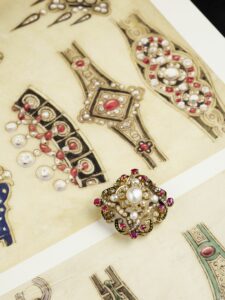
Jules Fossin period
Circa 1840
Yellow gold, silver, black enamel, fine pearls, rubies and diamonds
Chaumet Collection, Paris
Photo Credits: @ Pauline Guyon
How did the collaboration with GemGenève arise?
During the last edition of GemGenève in May 2023, I spoke with Mathieu Dekeukelaire, Director of GemGenève, and we agreed to work together to create a fascinating exhibition for the visitors and exhibitors. The idea was to combine science and heritage. Maison Chaumet has a strong link with pearls, and it is always glad to share its history. As Head of Heritage Jewelry Collection, I was closely involved in the project.
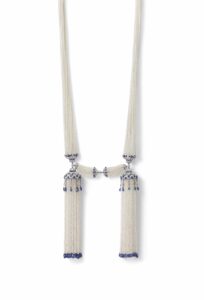
Joseph Chaumet period
1922 – 1924
Gold, platinum, seed pearls, sapphires and diamonds.
Chaumet Collection, Paris
Photo credits: @Nils Herrmann
Would you like to tell us more about the connection between Chaumet and the world of pearls?
Chaumet takes its name from Joseph Chaumet, who became Director of the Maison in 1885. However, the history of Chaumet began in the 1780s with Marie-Étienne Nitot, jeweler of Napoleon I and Empress Joséphine. The Emperor and Empress were both lovers of pearls, which were a symbol of power with their rare, expensive, and unique value, but also a symbol of love because of the roundness and softness of their shape. Joséphine and Napoleon were powerful but also deeply in love, as stated in the numerous letters Napoleon wrote to her. Josephine had a lot of pearls, and it is nearly impossible to find a painting where she was not wearing pearls. When Joseph Chaumet took over the business, he was very passionate, and he was also a skilled scientist. He started analyzing natural pearls, and how to distinguish natural from cultured pearls, and soon became so specialized that every aristocratic family of the time was purchasing pearls from him.
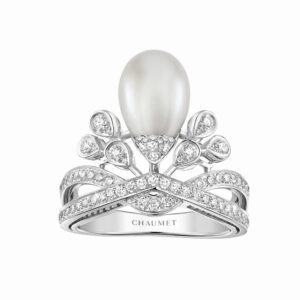
Chaumet, 2020
Platinum, diamonds and natural pearl
What are the highlights of “The Pearl Odyssey” exhibition?
Regarding history, the exhibition focuses on very “artistic” pieces of jewelry with pearls. We exhibited for example the belt that belonged to Empress Marie-Louise, the second wife of Napoleon I, made of 83 cm of gold, richly decorated with all the symbols representing the Empire (bees, stars, and laurel branches), and a multitude of pearls. The belt was a perfect example of how pearls can magnify an already splendid piece of jewelry. Additionally, I selected the “Bayadère” necklace (around 1922), a sautoir necklace made up of over 50.000 seed pearls, enhanced by materials such as platinum, diamonds, and sapphires. The necklace recently needed restoration. After the incredible restoration process was completed, we could hang the necklace exactly how it was supposed to be worn. Imagine a woman in the 1920s wearing it and dancing; picture the movement of the necklace! Regarding science, Chaumet selected more than 40 photographs taken by Joseph Chaumet from our archives dating back to the 1900s-1920s, regarding his studies on natural pearls and their formation, and cultured pearls. Also, it was possible to see extracts from his talks with dealers, privates, and institutions, in which he stated how important it was to be transparent to the client regarding the value and naturality of stones and pearls.
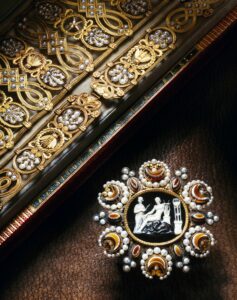
Marie-Etienne Nitot period
1812
Gold, sardonyx, and natural pearls. In its original case
Paris, Chaumet Collection
Photo Credits: @ Bruno Ehrs
We know that in history pearls represented a symbol of power and men used to wear them just as women… How do you see the evolution of pearls in time?
Pearls have always been an important symbol and men used to wear a lot of pearls. As society changed, “active men” ceased to wear pearls because in the workplace they preferred to wear functional jewels such as cufflinks or watches, and no more pearl brooches for example. Now this is changing, we see many men wearing pearls again. Fashion movements, societal shifts, and the roles of men and women in the workplace have all been contributing factors that impacted how we wear jewelry today. Also, cultured pearls shaped the market trend, cultured pearls are more affordable and are not only symbol of power and wealth as natural pearls, since icon as Coco Chanel pearls are symbol of look and fashion. When cultured pearls arrived in the market, the absence of national laboratory made it difficult for clients to understand whether they were buying natural or cultured pearls. Additionally, our oceans were being overfished without humanity respecting the lifecycle of oysters and marine fauna. Luckily, now the two markets (natural and cultured pearls) have managed to co-exist independently yet harmoniously in every Maison. Fashion is always a circle: pearls were out of fashion for a while but now they are definitely coming back.
What is your advice for young people who want to learn more about the world of pearls? And, for those who couldn’t visit “The Pearl Odyssey” exhibition, are there ways to see it in the future?
My advice is to go and see, experience, touch, and feel the jewelry. Auction houses are perfect places for this. You must be curious, explore, seek, and ask questions. “The Pearl Odyssey” exhibition was a one-time collaboration created exclusively for GemGenève; however, we have published a catalog regarding the exhibition, with specifics on all the jewels exhibited. Also, Maison Chaumet is always sharing culture and history through many initiatives: for example, now there is an exhibition in Place Vendôme, which is free and open to the public, about jewelry from the 70s and 80s.
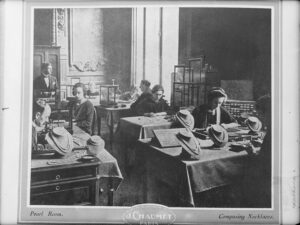
photograph (circa 1920).
Chaumet Collections (Paris).
